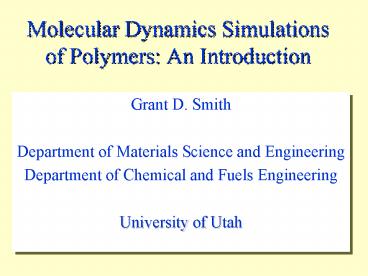Molecular Dynamics Simulations of Polymers: An Introduction - PowerPoint PPT Presentation
1 / 39
Title:
Molecular Dynamics Simulations of Polymers: An Introduction
Description:
Department of Materials Science and Engineering. Department of Chemical and Fuels Engineering ... Ab initio (Quantum Chemistry) molecular and cluster properties ... – PowerPoint PPT presentation
Number of Views:373
Avg rating:3.0/5.0
Title: Molecular Dynamics Simulations of Polymers: An Introduction
1
Molecular Dynamics Simulations of Polymers An
Introduction
- Grant D. Smith
- Department of Materials Science and Engineering
- Department of Chemical and Fuels Engineering
- University of Utah
2
Collaborators
- Dr. Thomas Sewell, LANL
- Dr. Frans Trouw, LANL
- Dr. Richard Jaffe, NASA Ames
- Dr. Dmitry Bedrov, University of Utah
- Oleg Borodin, Oleksiy Byutner
3
(No Transcript)
4
Outline
- What are molecular dynamics simulations?
- Why perform MD simulations of real materials?
- How
- do we perform simulations?
- do we obtain force fields?
- do we calculate properties?
- Examples Mechanisms and Predictions
5
What and Where Scales in Simulations
continuum
mesoscale
Monte Carlo
Time Scale
10-6 S
molecular
dynamics
domain
10-8 S
quantum
D
exp(-
E/kT)
chemistry
10-12 S
F MA
10-10 M
10-8 M
10-6 M
10-4 M
Length Scale
6
Motivation Why atomistic MD simulations?
- Mechanisms
- MD simulations provide a molecular level picture
of structure and dynamics ? property/structure
relationships - What if?
- Experiments often do not provide the molecular
level information available from simulations - Simulators and experimentalists can have a
synergistic relationship, leading to new insights
into materials properties
7
Motivation Why atomistic MD simulations?
- Property Prediction MD simulations allow
prediction of properties for - Novel materials which have not been synthesized
- Existing materials whose properties are difficult
to measure or poorly understood - Model validation
8
How MD Simulations Work The System
Poly(vinylidene fluoride)
9
How MD Simulations Work Classical Equations of
Motion
10
How MD Simulations Work The Force Field
bond stretch
torsional
intermolecular interactions
valence angle bend
intramolecular nonbonded
11
How MD Simulations Work The Force Field
12
How MD Simulations Work How Do We Get the
Parameters?
- Experiment
- molecular and bulk properties
- empirical
- Ab initio (Quantum Chemistry)
- molecular and cluster properties
- smaller scale than MD simulations
- first principles method
13
What and Where Scales in Simulations
continuum
mesoscale
Monte Carlo
Time Scale
10-6 S
molecular
dynamics
domain
10-8 S
quantum
D
exp(-
E/kT)
chemistry
10-12 S
F MA
10-10 M
10-8 M
10-6 M
10-4 M
Length Scale
14
Intermolecular Parameters
Li
1,2-dimethoxyethane (DME)
0
-10
-20
-30
binding energy (kcal/mol)
-40
-50
-60
-70
1
1.5
2
2.5
3
3.5
4
Li-oxygen separation (Å)
15
Intermolecular Parameters
1,2-dimethoxyethane
16
Intramolecular Parameters
1,2-dimethoxypropane (DMP)
17
Intramolecular Parameters
1,2-dimethoxypropane (DMP)
18
Now we are ready to simulate...
19
Statistical Mechanics Extracting properties
from simulations
- static properties such as structure, energy, and
pressure are obtained from pair (radial)
distribution functions
DME-water and DMP-water solutions
20
Statistical Mechanics Extracting properties
from simulations
- dynamic and transport properties are obtained
from time correlation functions
A R V
ó
ô
dt
T
lt
A
(t)
A
(0)gt
ô
õÿ
0
ltA(t) - A(0)2gt
lim
/2t
t
Polybutadiene, 353 K Mw 1600
21
Example PEO in Water
PEO is a water soluble polymer used in wide
variety of biomedical applications
poly(ethylene oxide)
22
- PEO exhibits LCST behavior
- DP gt 53
- results in a solubility gap
- PPO is insoluble behavior
- similar chemical structure
- PEO/PPO/PEO triblock surfactants (Pluronics)
- tunable LCST of random copolymers
23
Example PEO in Water
- Low Molecular Weight Analogs
- PEO and DME show nearly identical interactions
with water - DMP is water soluble
24
Prediction Water Self-Diffusion
25
Mechanism Water Clustering
DMP
DME
26
DMP
E 1.1 kcal/mol
E 0.7 kcal/mol
DME
E 0.2 kcal/mol
27
Example HMX Liquid
HE Material Binder
HMX
28
Example HMX Liquid
- Liquid phase properties are important for the
larger scale materials model (MPM) - Liquid phase properties cannot be obtained from
experiment
29
Liquid HMX Predictions
30
Example PEO/LiI
31
Prediction Ion Complexation
32
Prediction Ion Environment
33
Prediction Ion Clusters
34
Prediction Ion Complexation
35
Prediction Ion Mobility
36
Prediction Ion and Polymer Mobilities
37
Mechanism Li Motion
- Cations move with the polymer chain
38
Mechanism Li Motion
- Cations can hop between chains
hopping time 100 ns
39
Mechanism Conduction
- When tRlt hopping time, the cation moves with the
polymer - When tR is comparable to the hopping time, the
conduction mechanism changes - Conductivity should be independent of molecular
weight for molecular weights above Me.































